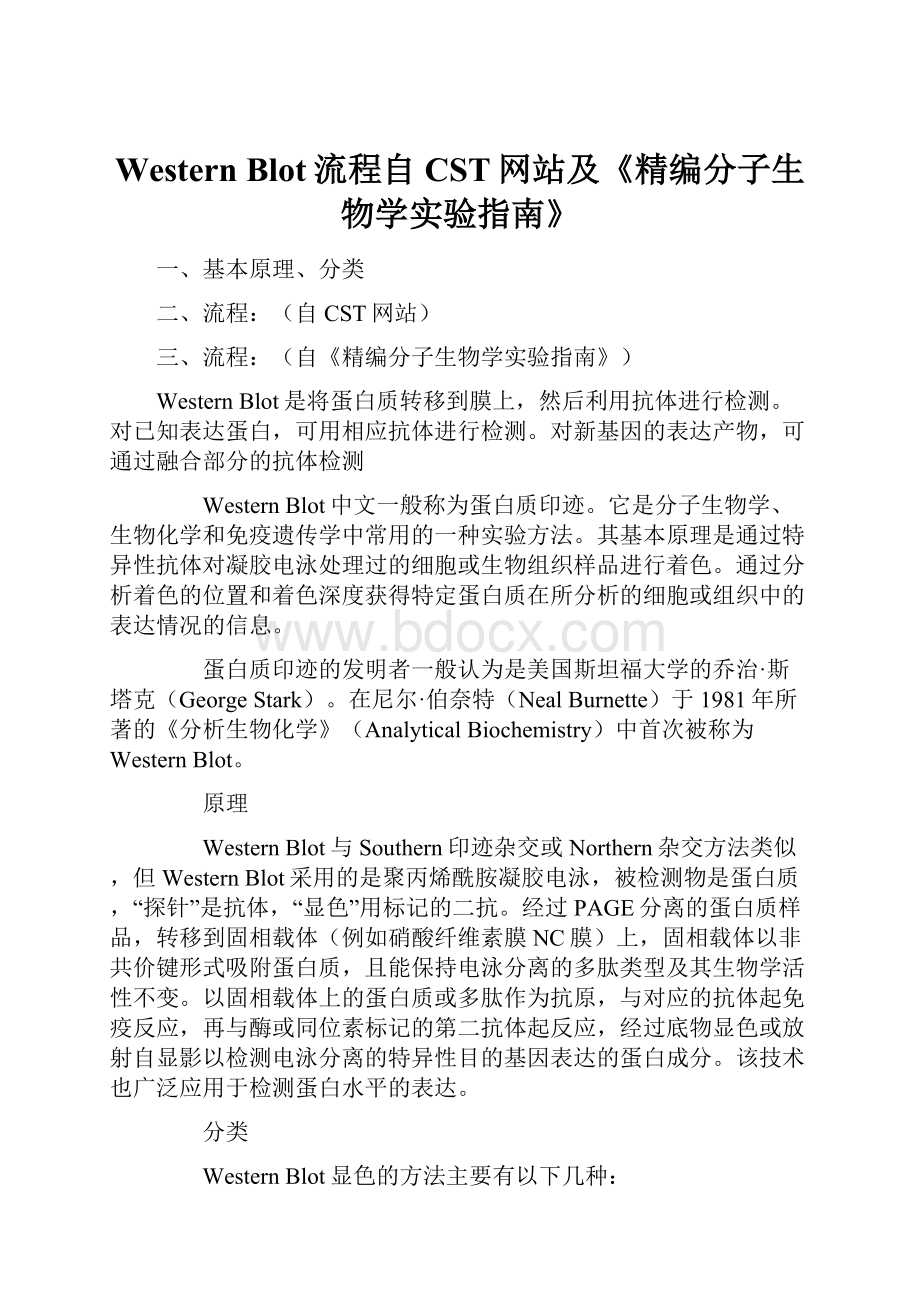Western Blot流程自CST网站及《精编分子生物学实验指南》.docx
《Western Blot流程自CST网站及《精编分子生物学实验指南》.docx》由会员分享,可在线阅读,更多相关《Western Blot流程自CST网站及《精编分子生物学实验指南》.docx(10页珍藏版)》请在冰豆网上搜索。

WesternBlot流程自CST网站及《精编分子生物学实验指南》
一、基本原理、分类
二、流程:
(自CST网站)
三、流程:
(自《精编分子生物学实验指南》)
WesternBlot是将蛋白质转移到膜上,然后利用抗体进行检测。
对已知表达蛋白,可用相应抗体进行检测。
对新基因的表达产物,可通过融合部分的抗体检测
WesternBlot中文一般称为蛋白质印迹。
它是分子生物学、生物化学和免疫遗传学中常用的一种实验方法。
其基本原理是通过特异性抗体对凝胶电泳处理过的细胞或生物组织样品进行着色。
通过分析着色的位置和着色深度获得特定蛋白质在所分析的细胞或组织中的表达情况的信息。
蛋白质印迹的发明者一般认为是美国斯坦福大学的乔治·斯塔克(GeorgeStark)。
在尼尔·伯奈特(NealBurnette)于1981年所著的《分析生物化学》(AnalyticalBiochemistry)中首次被称为WesternBlot。
原理
WesternBlot与Southern印迹杂交或Northern杂交方法类似,但WesternBlot采用的是聚丙烯酰胺凝胶电泳,被检测物是蛋白质,“探针”是抗体,“显色”用标记的二抗。
经过PAGE分离的蛋白质样品,转移到固相载体(例如硝酸纤维素膜NC膜)上,固相载体以非共价键形式吸附蛋白质,且能保持电泳分离的多肽类型及其生物学活性不变。
以固相载体上的蛋白质或多肽作为抗原,与对应的抗体起免疫反应,再与酶或同位素标记的第二抗体起反应,经过底物显色或放射自显影以检测电泳分离的特异性目的基因表达的蛋白成分。
该技术也广泛应用于检测蛋白水平的表达。
分类
WesternBlot显色的方法主要有以下几种:
i.放射自显影
ii.底物化学发光ECL
iii.底物荧光ECF
iv.底物DAB呈色
现常用的有底物化学发光ECL和底物DAB呈色,体同水平和实验条件的是用第一种方法,目前发表文章通常是用底物化学发光ECL。
只要买现成的试剂盒就行,操作也比较简单,原理如下(二抗用HRP标记):
反应底物为过氧化物+鲁米诺,如遇到HRP,即发光,可使胶片曝光,就可洗出条带。
[编辑本段]其他
值得一提的是,westernblot这个名称的由来很有意思。
最开始做印迹工作的是一个叫做Southern的科学家,但印迹的对象是DNA链,他把这种技术称为Southernblot,后来类似的出现了两个过程相似,但是对象不同的印迹方法,一个针对RNA,一个对蛋白质,人们分别把这两种技术的称为Northern和Western,与这两个技术的发明人没有关系了。
返回
WesternImmunoblottingProtocol(PrimaryAbIncubationInBSA)<录自CST网站>
ForWesternblots,incubatemembranewithdilutedantibodyin5%w/vBSA,1XTBS,0.1%Tween-20at4°Cwithgentleshaking,overnight.返回
ProductsavailablefromCellSignalingTechnologyarelinkedbytheirrespectivecatalognumbers.
A.SolutionsandReagents
NOTE:
PreparesolutionswithMilli-Qorequivalentlypurifiedwater.
1.1XPhosphateBufferedSaline(PBS).
2.1XSDSSampleBuffer:
(#7722,#7723)62.5mMTris-HCl(pH6.8at25°C),2%w/vSDS,10%glycerol,50mMDTT,0.01%w/vbromophenolblueorphenolred.
3.TransferBuffer:
25mMTrisbase,0.2Mglycine,20%methanol(pH8.5).
4.10XTrisBufferedSaline(TBS):
(#9997)Toprepare1literof10XTBS:
24.2gTrisbase,80gNaCl;adjustpHto7.6withHCl(useat1X).
5.NonfatDryMilk:
(#9999)(weighttovolume[w/v]).
6.BlockingBuffer:
1XTBS,0.1%Tween-20with5%w/vnonfatdrymilk;for150ml,add15ml10XTBSto135mlwater,mix.Add7.5gnonfatdrymilkandmixwell.Whilestirring,add0.15mlTween-20(100%).
7.WashBuffer:
1XTBS,0.1%Tween-20(TBS/T).
8.BovineSerumAlbumin(BSA):
(#9998).
9.PrimaryAntibodyDilutionBuffer:
1XTBS,0.1%Tween-20with5%BSA;for20ml,add2ml10XTBSto18mlwater,mix.Add1.0gBSAandmixwell.Whilestirring,add20μlTween-20(100%).
10.Phototope®-HRPWesternBlotDetectionSystem:
(#7071anti-rabbit)or(#7072anti-mouse)Includesbiotinylatedproteinladder,secondary(#7074anti-rabbit)or(#7076anti-mouse)antibodyconjugatedtohorseradishperoxidase(HRP),anti-biotinantibodyconjugatedtoHRP,LumiGLO®chemiluminescentreagentandperoxide.
11.PrestainedProteinMarker,BroadRange(PremixedFormat):
(#7720).
12.BiotinylatedProteinLadderDetectionPack:
(#7727).
13.BlottingMembrane:
Thisprotocolhasbeenoptimizedfornitrocellulosemembranes,whichCSTrecommends.PVDFmembranesmayalsobeused.
B.ProteinBlotting
Ageneralprotocolforsamplepreparationisdescribedbelow.
1.Treatcellsbyaddingfreshmediacontainingregulatorfordesiredtime.
2.Aspiratemediafromcultures;washcellswith1XPBS;aspirate.
3.Lysecellsbyadding1XSDSsamplebuffer(100μlperwellof6-wellplateor500μlperplateof10cmdiameterplate).Immediatelyscrapethecellsofftheplateandtransfertheextracttoamicrocentrifugetube.Keeponice.
4.Sonicatefor10–15secondsforcompletecelllysisandtoshearDNA(toreducesampleviscosity).
5.Heata20μlsampleto95–100°Cfor5minutes;coolonice.
6.Microcentrifugefor5minutes.
7.Load20μlontoSDS-PAGEgel(10cmx10cm).NOTE:
CSTrecommendsloadingprestainedmolecularweightmarkers(#7720,10μl/lane)toverifyelectrotransferandbiotinylatedproteinladder(#7727,10μl/lane)todeterminemolecularweights.
8.ElectrotransfertonitrocelluloseorPVDFmembrane.
C.MembraneBlockingandAntibodyIncubations
NOTE:
Volumesarefor10cmx10cm(100cm2)ofmembrane;fordifferentsizedmembranes,adjustvolumesaccordingly.
1.(Optional)Aftertransfer,washnitrocellulosemembranewith25mlTBSfor5minutesatroomtemperature.
2.Incubatemembranein25mlofblockingbufferfor1houratroomtemperature.
3.Washthreetimesfor5minuteseachwith15mlofTBS/T.
4.Incubatemembraneandprimaryantibody(attheappropriatedilution)in10mlprimaryantibodydilutionbufferwithgentleagitationovernightat4°C.
5.Washthreetimesfor5minuteseachwith15mlofTBS/T.
I.ForUnconjugatedPrimaryAntibodies
1.IncubatemembranewithappropriateHRP-conjugatedsecondaryantibody(1:
2000)andHRP-conjugatedanti-biotinantibody(1:
1000)todetectbiotinylatedproteinmarkersin10mlofblockingbufferwithgentleagitationfor1houratroomtemperature.
2.Washthreetimesfor5minuteseachwith15mlofTBS/T.
II.ForHRPConjugatedPrimaryAntibodies
SkiptoDetectionofProteins(StepD).
III.ForBiotinylatedPrimaryAntibodies
1.IncubatemembranewithHRP-Streptavidin(attheappropriatedilution)inmilkforonehourwithgentleagitationatroomtemperature.
2.Washthreetimesfor5minuteseachwith15mlofTBS/T.
D.DetectionofProteins
1.Incubatemembranewith10mlLumiGLO®(0.5ml20XLumiGLO®,0.5ml20XPeroxideand9.0mlMilli-Qwater)withgentleagitationfor1minuteatroomtemperature.NOTE:
LumiGLO®substratecanbefurtherdilutedifsignalresponseistoofast.
2.Drainmembraneofexcessdevelopingsolution(donotletdry),wrapinplasticwrapandexposetox-rayfilm.Aninitial10-secondexposureshouldindicatetheproperexposuretime.NOTE:
Duetothekineticsofthedetectionreaction,signalismostintenseimmediatelyfollowingLumiGLO®incubationanddeclinesoverthefollowing2hours.
postedJune2005revisedOctober2008
返回
(以下摘自《精编分子生物学实验指南》)返回
返回